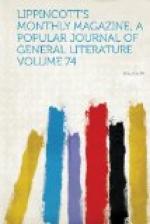[Illustration: The school-house of the past and the present.]
Our system of public schools, long classed among the “peculiar institutions” of the country, is notably gaining in scope and efficiency, be the English and Prussians right or not in their claim of greater thoroughness and a higher curriculum. The different States have engaged in a series of competitive experiments for the common good, and cities and counties, in their sphere, labor to the same end. Schools of higher grade are being multiplied, and the examination of teachers, still lax enough, becomes more exact and faithful, as befits the drill of an army of two hundred and forty thousand charged with the intellectual police of eight millions of children—the number said by the new “National Bureau of Education” to have been enrolled in 1875, against 7,209,938, 5,477,037 and 3,642,694 by the censuses of 1870, ’60 and ’50. Little more than half this number is estimated by the Bureau to represent the average daily attendance, which is quite compatible with the attendance, for the greater part of the school-year, of nine-tenths of the whole number on the lists. A comparison of the number enrolled and the entire supposed number of children between six and sixteen leaves an excess of nearly two millions and a half outside the public schools. Of these private schools will account, and account well, for a large proportion. These are fulfilling indispensable offices, one being that of normal schools—a want likely to be inadequately satisfied for a long time to come.
In one respect our public schools are beyond, though not above, comparison with those of the most advanced European states. An annual outlay of a trifle less than seventy-five millions of dollars, with an investment in buildings, ground, etc. of a hundred and sixty-six millions, implies a determination that should be rewarded with the most unexceptionable results. It reaches eighteen dollars yearly, leaving out the interest on the fixed stock, for each child in daily attendance. Such an expenditure, trebling, we believe, that of Prussia, ought to secure better teachers and a higher range of instruction. It must be said, however, that the duties of the school-boards




